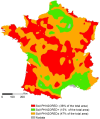Management of soil pH promotes nitrous oxide reduction and thus mitigates soil emissions of this greenhouse gas
- PMID: 31882900
- PMCID: PMC6934481
- DOI: 10.1038/s41598-019-56694-3
Management of soil pH promotes nitrous oxide reduction and thus mitigates soil emissions of this greenhouse gas
Abstract
While concerns about human-induced effects on the Earth's climate have mainly concentrated on carbon dioxide (CO2) and methane (CH4), reducing anthropogenic nitrous oxide (N2O) flux, mainly of agricultural origin, also represents an opportunity for substantial mitigation. To develop a solution that induces neither the transfer of nitrogen pollution nor decreases agricultural production, we specifically investigated the last step of the denitrification pathway, the N2O reduction path, in soils. We first observed that this path is mainly driven by soil pH and is progressively inhibited when pH is lower than 6.8. During field experiments, we observed that liming acidic soils to neutrality made N2O reduction more efficient and decreased soil N2O emissions. As we estimated acidic fertilized soils to represent 37% [27-50%] of French soils, we calculated that liming could potentially decrease France's total N2O emissions by 15.7% [8.3-21.2%]. Nevertheless, due to the different possible other impacts of liming, we currently recommend that the deployment of this solution to mitigate N2O emission should be based on local studies that take into account agronomic, environmental and economic aspects.
Conflict of interest statement
The authors declare no competing interests.
Figures





References
-
- UNEP, Drawing down N2O to protect climate and ozone layer. A UNEP synthesis report. United Nations Environment Programme (UNEP). Nairobi, Kenya (2013).
-
- Myhre, G. et al. Anthropogenic and Natural Radiative Forcing. In: Climate Change 2013: The Physical Science Basis. Contribution of Working Group I to the Fifth Assessment Report of the Intergovernmental Panel on Climate Change [Stocker, T. F. et al. (eds)]. (Cambridge University Press, Cambridge, United Kingdom and New York, NY, USA, 2013).
-
- Pellerin S, et al. Identifying cost-competitive greenhouse gas mitigation potential of French agriculture. Environ. Sci. Policy. 2017;77:130–139. doi: 10.1016/j.envsci.2017.08.003. - DOI
Publication types
Grants and funding
LinkOut - more resources
Full Text Sources
Research Materials

